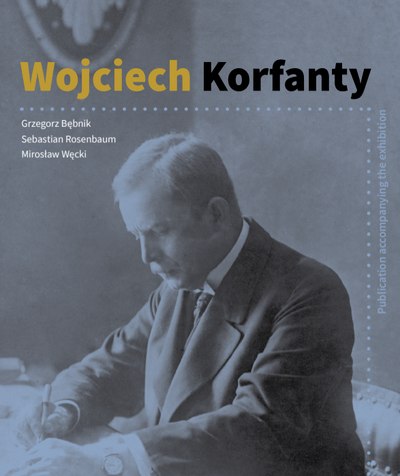Grzegorz Bębnik, Sebastian Rosenbaum, Mirosław Węcki, Wojciech Korfanty, IPN, Muzeum Śląskie, Katowice 2020, 80 s., ISBN 978-83-8098-844-6
Publikacja nie jest przeznaczona do sprzedaży.
Popularna pozycja w jęz. angielskim, przygotowana w Oddziale IPN w Katowicach. Autorami są historycy z Oddziałowego Biura Badań Historycznych IPN w Katowicach.
Wykorzystano unikatowe zbiory: Archiwum Archidiecezjalnego w Katowicach, Narodowego Archiwum Cyfrowego, Archiwum Państwowego w Katowicach, Biblioteki Narodowej, Biblioteki Śląskiej, Bibliothèque nationale de France, Muzeum Czynu Powstańczego (Góra Św. Anny), Muzeum Historii Katowic, magazynu „Life“, Adama Waliczka i prywatne archiwa.
W języku polskim książka ukazało się w 2019 r., jej prezentacja towarzyszyła wystawie plenerowej pokazanej w Łazienkach Królewskich w Warszawie w lipcu 2019 r.. Projekt został zrealizowany w ramach obchodów stulecia odzyskania niepodległości oraz odbudowy polskiej państwowości oraz w związku z obchodami 100-lecia Powstań Śląskich.
***
Wojciech Korfanty has a special role in the history of Upper Silesia. As early as in the first years of his public activities at the turn of the 19th and 20th century, he gained great popularity in the region, which soon turned into a true legend. Despite many controversies around his political journey, the legend survived for decades, and the dramatic death at the end of the Second Polish Republic, in August 1939, made it even stronger. Today, Korfanty is considered to be one of the leading Polish politicians who are credited with a major share in Poland’s regaining of independence – the socalled Fathers of Independence, alongside such personalities as Józef Piłsudski, Roman Dmowski, Ignacy Jan Paderewski, Ignacy Daszyński and Wincenty Witos.
On the political scene of Upper Silesia, or more precisely its Prussian (Regierungsbezirk Oppeln), Korfanty made his appearance in the name of the national democracy movement, challenging the powerful German and Catholic Centre Party. He attacked the German policy towards the native population, using both the forum of the Reichstag (the Reich Parliament) the rallies and the newspapers he founded. Just before and during the First World War, his activity slowed down, however, after the collapse of Germany in 1918 he returned to politics, entering the national political scene with impetus. Participation in the authorities of Wielkopolska and involvement during the time of the Wielkopolska Uprising were a kind of introduction to the most important episode in Korfanty’s biography. It was the battle for 6 Upper Silesia, fought in the years 1919 – 1921 from the position of the head of the Polish Plebiscite Committee and the dictator of the Third Silesian Uprising.
In the interwar period, he became one of the pillars of the new socio-political situation in the autonomous Silesian Voivodeship. Although he did not hold an official function and rank, he was a member of many economic bodies, as well as the head of a profitable press concern, and his daily newspaper “Polonia” played a significant political role in the voivodeship and in the country. However, since 1926 the star began to fade. He became an object of attacks from the Sanation authorities, as he was a strong opponent of Piłsudski and his people in the Silesian Voivodeship. Deprived of political influence, more and more often he was taking the pen to promote Christian-democratic ideas that were close to him. The fall of his political career was bitter. The first great stroke was his imprisonment by senators in Brest-on-the-Bug. Then came the forced emigration to Czechoslovakia. And finally, after his return to Poland in spring 1939 – imprisonment during his illness.
The biography of the politician is full of sudden turns and changes. A populist tribune, a harsh journalist, an MP with rhetorical talent, an excellent promoter of the plebiscite action and a prudent uprising dictator, an efficient publisher and a respected promoter of Catholic social teaching – many lives could be bestowed with these attributes. Although Korfanty is put on the pedestal, above all, he remains an exceptionally colourful, intriguing character of 20th century history.
TABLE OF CONTENTS
Introduction
Beginnings and identity choices
In the national movement
“Precz z Centrum” (Away with the Centre Party)
The fight for parliament and the marriage
To the margin and back to politics
In the Naczelna Rada Ludowa (Supreme People’s Council) in Poznań
Fighting for Upper Silesia
Uprising Dictator
Prime Minister of the Republic of Poland?
Conflict with Sanation
The imprisonment and the Brest trial
Leading the Polish Christian Democrats
Last years
Epilogue
 E-Księgarnia
E-Księgarnia